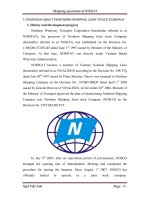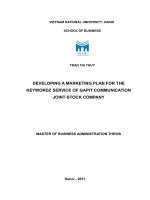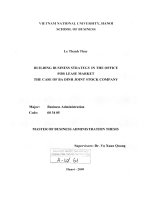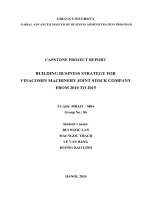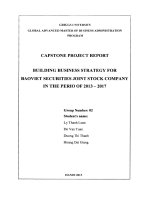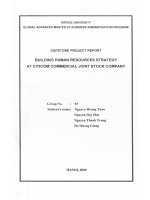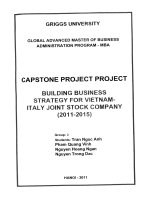ESTABLISHMENT OF BUSINESS STRATEGY OF DANANG RUBBER JOINT STOCK COMPANY
Bạn đang xem bản rút gọn của tài liệu. Xem và tải ngay bản đầy đủ của tài liệu tại đây (574.92 KB, 67 trang )
THESIS MBA
ESTABLISHMENT OF BUSINESS
STRATEGY OF DANANG RUBBER JOINT
STOCK COMPANY
IN 2011-2015 PERIOD
HANOI, AUGUST 2011
Table of Contents
Table of Contents.....................................................................................................................................................2
CHAPTER I: INTRODUCTION.....................................................................................................................................1
1. GENERAL CONTEXT AND RATIONALE................................................................................................................1
1.1 General Context..........................................................................................................................................1
1.2 Rationale....................................................................................................................................................2
1.3 The significance of the subject...................................................................................................................2
2. OBJECTIVES OF THE TOPIC................................................................................................................................3
2.1 General objective........................................................................................................................................3
2.2 Specific objectives......................................................................................................................................3
3. OBJECTS AND SCOPE OF RESEARCH..................................................................................................................3
3.1 Research objects.........................................................................................................................................3
3.2 Scope of research.......................................................................................................................................4
4. METHODOLOGY................................................................................................................................................4
5. THE STRUCTURE OF THE SUBJECT...................................................................................................................4
CHAPTER II: CONTENT ANALYSIS..............................................................................................................................5
PART 1: RATIONALE OF STRATEGIC BUSINESS CONSTRUCTION IN ENTERPRISES..................................................5
1.1 Business strategy of an enterprise..............................................................................................................5
1.1.1 The concept and characteristics of business strategy..........................................................................5
1.1.2 Classification of business strategy........................................................................................................6
1.1.3 The role of strategic planning within the business activity of enterprises...........................................7
1.1.4 The level of strategic management......................................................................................................8
1.2 The process of building and choosing business strategy.............................................................................9
1.2.1 The process of building business strategy............................................................................................9
1.2.2 Research business environment........................................................................................................10
1.2.3 Build and choose feasible trading strategy options...........................................................................18
PART 2: ANALYSIS OF THE REALITY AND STRATEGIES OF BUSINESS OF THE DANANG RUBBER JOINT STOCK
COMPANY...........................................................................................................................................................20
2.1 General introduction about Danang rubber joint stock Company............................................................20
2.1.1 The history of formation and development of the company.............................................................20
2.1.2 Functions and duties of the company................................................................................................21
2.1.3 Structure the Organization of company.............................................................................................22
2.1.4 Vision mission and core values of the business.................................................................................23
2.2 Analyze the business environment of the Enterprise...............................................................................23
2.2.1 Analysis of external environment......................................................................................................23
2.2.2 Analysis of internal business..............................................................................................................37
2.3 General SWOT matrix...............................................................................................................................49
PART 3: OPTIONS TRADING STRATEGIES FOR THE DANANG RUBBER JOINT STOCK COMPANY PERIOD 20112015 AND SOME SOLUTIONS IMPLEMENTED.....................................................................................................50
3.1 Development orientation and vision mission during the next stage.........................................................50
3.2 The goal....................................................................................................................................................50
3.3 Building strategies....................................................................................................................................51
3.3.2 SWOT analysis matrix.........................................................................................................................52
3.3.3 Analysis by matrix GREAT...................................................................................................................53
3.4 Strategic options.......................................................................................................................................55
3.5 Solution implementation strategy............................................................................................................55
3.5.1 Current market penetration Strategy; Market Development Strategy and Product development
Strategy......................................................................................................................................................55
3.5.2 Built along the near future Strategy..................................................................................................57
3.5.3 Low-cost strategy...............................................................................................................................58
CHAPTER III: CONCLUSION.....................................................................................................................................61
LIST OF REFERENCES...............................................................................................................................................62
LIST OF TABLES
LIST OF FIGURES
Figure 2.1: Structure the Organization of DRC (Source: DRC Annual Report 2010)................................................22
Figure 2.2: GDP and CPI growth over the year (Source: GSO)................................................................................25
Figure 2.3: The model defined business units (Source: Derek F. Abell)..................................................................29
Chart 2.1: The market share of some tire manufacturers in 2010 (Stock Analysis Report DRC, dated 10/03/2011
of the APEC Securities)...........................................................................................................................................34
Figure 2.4.: Barriers and benefits (Source: Michael E. Porter)................................................................................34
BARRIERS TO WITHDRAW......................................................................................................................................34
LIST OF ABBREVIATIONS
1. DRC: Danang Rubber joint stock Company
2. GDP: Gross Domestic Product
3. CPI: Consumer Price Index
4. GSO: General Statistics Office
CHAPTER I: INTRODUCTION
1. GENERAL CONTEXT AND RATIONALE
1.1 General Context
In today’s increasingly complex global economy, the world witnessed numerous
companies with hundred-year experience filing for bankruptcy, or thousands of small and
medium-sized enterprises growing like mushrooms and then weakening quickly. That fact
shows us the importance of harsh competitive factors outside the businesses, which can
change the entire enterprise.
During the period of developing market economies to open integration into the
regional and global economies, most of all Nations must admit the vital existence of
competitiveness in all activities. The constantly enhance the ability to adapt to fluctuations
of the environment has become a rule of thumb in business.
To do this, businesses must define clear where to go, how to do and which
difficulties and challenges to be overcome? And the more important thing is how to unite
all members of the enterprise with concentration, unanimity, and hard efforts for the success
of the business. This first and foremost depends on the formulation and implementation of
business strategy, accurate strategic business will be ensuring the existence, sustainable
development, over the long term goals of the business. More than ever the functional and
financial leadership of CEOs in the businesses should promote maximum adaptation to
external environment and give out solution to deal with the changes; those businesses then
can survive and grow sustainably. The above fact shows us the necessity of management in
the strategy for growth adapted completely on the customers, in figuring out the solution for
business to best meet the needs of customers.
1
1.2 Rationale
In the present Vietnam’s context, economic growth is relatively stable, the rate of
GDP increases steadily over the years. Political stability, exchange policy in 2011 has been
under strict control by the State Bank of Vietnam. Having good relations with regional and
global currency organizations, in 2010 Vietnam served as a Chairman of the ASEAN bloc,
this is the best condition for your businesses to reach good opportunities.
However after joining into WTO in the past years, Vietnam has not exerted all the
advantages that businesses are at risk of being conquered and bankrupted because most of
them are processing companies with low value added. Their supply is largely dependent on
foreign partners, they failed to control domestic supply and to bring stability, on the other
hand depend on the exchange rate policy of the State.
Danang rubber joint stock Company (DRC) is not the outsider. The Company also
reveals many existing problems, which need to be adjusted and solved in the right direction
for the business and sustainable development of the business.
With significant practices, we have chosen the topic: "Establishment of business
strategy of Danang rubber joint stock Company in 2011-2015 periods" for management
strategy subject. The topic conveys brief situation of building and managing strategic
business; identifies strengths, weaknesses of current business, identifies opportunities,
challenges for the development in the near future.
The team has based on the situation and the results of previous strategy development
associated with the situation in the world, the situation in the country during the period
2011-2015 and orientation for the development of business in the future to formulate
development strategies in the period 2011-2015.
1.3 The significance of the subject.
On the basis of research and practice in Danang rubber joint stock Company, there
are two primary goals for the themes we set out:
2
-
Analyze the determinants of success or failure in the operation of the company,
based on which build accurate and efficient strategic business.
-
Identify and offer solutions to develop and apply business strategies aimed at
improving the efficiency and sustainable development of the Company. From which,
it is necessary to build a specific orientation, specific goals to promote the resource
and use it effectively to achieve their objectives.
2. OBJECTIVES OF THE TOPIC
2.1 General objective
Based on the topic in research to find out the strengths, weaknesses, risks,
opportunities and challenges, the general objective of the report is to assess its true power
and to come up with measures to improve competitiveness in order to reach number 1
position in the field of their business.
2.2 Specific objectives
Formation and development strategy for enterprise in the period 2011-2015, our
solutions focus on breakthroughs in:
• Develop of corporate culture.
• Improve financial capability.
• Improve the quality of service and quality of customer-oriented products
• Invest into development and expansion of market share, into new technologies in
order to meet the needs of the market.
3. OBJECTS AND SCOPE OF RESEARCH
3.1 Research objects
Object of the subject focuses on the study of the business, and business situation
through annual reports and statistics. Ongoing business strategy of the company, focuses
3
mainly on the external factors, the inside resources from which to draw lessons and improve
the business strategies of enterprises in the period 2011-2015.
3.2 Scope of research
With above research objects and specific goals, the scope of the study will be in the
range Of Danang rubber joint stock Company, its competitors and its industry environment.
4. METHODOLOGY
After studying, making some references, we chose the following methods used to
complete the subject:
- Method of statistical analysis;
- Method of historical research;
- Comparative and synthesized method;
- Methods of prediction, authentication (explanations and predictions);
- Standard analysis Method - options and decisions;
- By the analysis tools like matrix EFE, IFE, SWOT, Pest and method of qualitative,
quantitative analysis.
The data are also collected through the financial sites, General Statistics Office site and
annual reports of the company.
5. THE STRUCTURE OF THE SUBJECT
The report consists of 3 chapters with the following content:
Chapter I: Introduction to the topic
Chapter II: Content analysis
Chapter III: Conclusions.
4
CHAPTER II: CONTENT ANALYSIS
PART 1: RATIONALE
ENTERPRISES
OF
STRATEGIC
BUSINESS
CONSTRUCTION
IN
1.1 Business strategy of an enterprise
1.1.1 The concept and characteristics of business strategy
There are many ways to define business strategy; different approaches bring
economists different concepts about business strategy, such as:
-
Business strategy as a tool approach: business strategy is an art of building competitive
advantages and aims to bring the most favorable condition, evaluate right time to attack or
retreat to define agreed border and ensure its championship.
-
Business strategy as a management plan concept: business is to define basic and long-
term goals of enterprises, to choose policies, programs in order to allocate resources to get
above basic goals.
-
Business strategy as planning approach: business strategy is a concept or a plan
integrating main goals: policies, programs etc into one connected body to ensure basic goals
of enterprises.
-
The most common approach of business strategy: business strategy is the goal of long-
term policies, the allocation of, and coordination of the necessary resources and operational
business unit within the overall strategy of the enterprises.
Some typical characteristics of the strategy are demonstrated as follow:
-
Clearly define basic objectives and directions of business in each period.
-
Calculate orientations of the strategy to ensure business development and sustainability
in the situation of economic fluctuations.
5
-
Business strategy ensures to maximize and combine optimum exploitation and use of
existing resources and in the future, exert the advantages and seize the opportunity to
enhance their competitiveness.
-
Business strategy of the enterprise reflects throughout a continuous process and aims to
success in the field of business and is often built for period of 3 years, 5 years, or 10
years.
1.1.2 Classification of business strategy
a. Classification based on the scope of the business strategy effects.
General strategy: is the strategy referring to the most important issue, having the
widest coverage and meaningful for a long time. It is considered to decide survival issues
of the business.
Strategies in the business level unit
or
business field: are the competitive
strategies, competing with low prices, with the product and service differentiation, and
create a separate strategy part.
Business unit strategy: is functioning strategy, consisting of manufacturing strategy,
finance, human resource development, marketing, communications activities, research and
development etc including:
-
Trading strategy: the strategy of long-term policies in order to determine the
location of the enterprise.
-
Financial strategy: the set of long-term policy aimed at ensuring the proper financial
need to pursue the goals of trade with the conditions set out by the capital markets.
-
Production strategy: a collection of long-term policies in order to determine the type
of products, the number of each type and allocate media or resources in an effective
way to market.
-
Social strategy: a set of policy on establishing enterprise's behavior with regard to
labor market.
6
-
Technology innovation strategy: a set of policies aiming at research and
development of new products, new technologies and improving existing products
and methods are used.
-
Procurement strategy and logistics: a collection of policies to ensure that businesses
purchase and consume a good product.
The above strategies impact together, one strategy is the premise to determine other
strategy and implementing one strategy will affect the implementation of the strategy of the
others.
b. Classification based on the approach of business strategy
Strategy based on key factors: the guiding ideology of business activities is not
spreading the resources but accrue to focus for business is of decisive significance for the
production of business.
Flexible business strategies based on the relative advantages: starting from the
analysis, comparison of your products or services against your competitors, finding out the
strengths, weaknesses to become foundation for business strategy.
-
Strategy of creative attack: is built by looking straight into the popularity theme.
-
Strategy for potential exploitation: is exploring potential of favorable factors,
potential use of excess resources, resources in support of the major business areas.
So, when defining business strategy, businesses must base on the orientation of
economic development, social policy of the State, survey on market demand, analysis
results, calculations, predictions about the resource that businesses can exploit. Because the
business strategy must always be adjusted, whenever large fluctuations of advocates and
major change of the environment occur.
1.1.3 The role of strategic planning within the business activity of enterprises
Strategic planning helps businesses realize clear their purpose, direction. It is
considered as the basis for all actions planned in particular, as the guideline for all activities
of business enterprises.
7
-
Business strategy helps businesses understand and take advantage of business
opportunities and actively overcome the risks and threats in the business.
-
Business strategy contributes to improving the efficient use of resources, strengthens
competitive position and enables sustainable development.
-
Business strategy is a basis for firms to make business decisions in accordance with
the fluctuation of the market.
1.1.4 The level of strategic management
There are a variety of strategies used in an organization, but basically there are three
levels of strategies commonly used:
-
Corporate level strategy: Set goals and business activities of companies; create
policies and basic plans to achieve goals.
-
Business level strategy: Identify market and business operations of the company, and
product segment for each type of market.
-
Functional level strategy: Identify solutions and plans for individual business areas.
1.1.5 Business strategies that businesses are implementing.
-
Strategy to consolidate market share: consolidate, enhance the image, reputation of
the business, and expand the scale of production, labor productivity growth and
further penetration into the market.
-
Strategy to diversify products and services: diversify of product-oriented product to
the customer's needs; invest in modern communication line to offer a wide range of
products for the domestic market and export to foreign countries, especially the
dedicated products.
-
Strategy to expand network allocation: diversify and expand the distribution channel
of the business, expand the wide area in order to give customers the most
convenience when dealing to attract clients and increase competitiveness.
-
Concentration strategy: business focuses all its resources to achieve their goals of
growth and effectiveness.
8
-
Differentiation strategy: draw up plans based on existing strengths, peculiarities of
the business in order to achieve that goal.
1.2 The process of building and choosing business strategy
Building business strategy is the process of defining goals and tasks in the business
activities of enterprises, the best method to implement the goals and tasks. The process of
building strategy includes the following basic steps:
1.2.1 The process of building business strategy.
An overview of the phases and activities in the process of building a strategy is
illustrated as follow:
Step 1: Systematic information.
The strategy by collecting data, in combination with intuition, analyses the fact given and
select strategic viable alternative by some technical management strategies as: matrix
evaluation of external factors (EFE), matrix evaluation of internal factors (IFE).
Step 2: Merge Information to make a viable strategy business.
By using the sorted elements gathered from the environment side, outside of the business to
offer strategic business feasible by using several tools, such as SWOT matrix, the matrix
SPACE etc.
Step 3: Use overall information to choose a good trading strategy for businesses.
By using the information in the first step, assessing objective step 2 to choose a strategy for
trading the key through a number of tools like matrix QSPM, matrix GREAT….
To ensure the highest efficiency during operation, the strategy-makers were forced
to make decisions in choosing strategies which will benefit the company the most. The
decision in the phase strategy will add organization to products, markets, technology for a
prolonged period. The competitive advantage in the long term is clearly defined in the
strategy. This phase is very important for the strategic decisions that will have lasting
impact or better or worse for the organization.
9
1.2.2 Research business environment
1.2.2.1 Macro environment
Macro environment includes external factors, which influence indirectly to
businesses and enterprises almost impossible to control. These factors indicate trends or
circumstance changes, can have positive impacts (opportunities) or negative (threatening)
for business. However it doesn’t mean that all happens in these areas is an opportunity or a
threat; many changes occurred without affect to business. We are interested in the field of
macro environment as follows:
* Economic factors: The economic sphere consists of all of the ongoing macro-economic data,
statistics, trends and changes. These statistics are very useful for the assessment and
competitive environment of the business. The economic information includes: bank interest
rates, exchange rates and price of the dollar, budget surplus or deficit, trade surplus or deficit,
inflation, gross domestic product, the results of economic cycles, income and expenditure, the
level of debt, unemployment rate, productivity of labor and Government policy.
* Elements of the population: The population that need attention includes information such
as gender, age, income, racial, educational qualifications, interests, demographics,
geographic location, rate, unemployment rate, etc. The most important thing is to appreciate
trend and change of population. This information will establish your current customers and
potential business in the future. Furthermore, the administrators will understand more about
opportunities to market that business and the marketplace that businesses want to penetrate.
* Elements of culture and society: to be understood as the value of living the spirit of every
nation, every country that creates its own characteristics in the way people consume as well as
the intangible obstacles that businesses encounter when penetrating the market. Therefore
comprehensive research is needed to avoid negative reactions of people due to the invasive and
traditional values. Technical research on factors such as lifestyle, opinion, psychology, enter,
the administrator will avoid the damage or impair the reputation of the business, which is also
the base needed to establish the market properties and focus on sales.
10
* Political law: consisting of the regulation, the laws of the State related to goods
production and trading businesses. These changes are likely to alter the rules, and raise the
difficulties for the business. Not only concern with legal issues businesses also pay
attention to the political parties involved in their own right, because each change of
Government is a series of new policies. Political stability, policies on taxation, policy
export, and import changes seriously affect on revenue, profitability of the business, even
reduce the competitiveness of businesses.
* Technological factors: the continuous improvement of science and technology has
increased labor productivity as well as the generation of new products with unique features
and create competitiveness for businesses to catch the technology there. Accompanying the
progress is the trend of social development; which can transform the needs of people from
low to high, require businesses to put a major effort in technology to meet the needs....
* There are also a number of other influential factors such as, business environment, the
trend of the world economies , the institutions of other countries, other institutions; all of
them can affect businesses.
1.2.2.2 Micro-environment
Micro environment includes the external components impacting business and direct
these so-called environmental industries. It can be defined as a group or group of
enterprises trading in products similar to or the same. These businesses compete with each
other to gain market share and secure but necessary resources (inputs) to transform the
(process) into the product (output). One of the most common ways used to analyze and
evaluate information about specific environment is a pattern of five (5) forces introduced
by Michael Porter, including:
* Factor suppliers: is one important factor directly affecting the operation of the business.
When you see the business as an open system it was inevitable that businesses will have
received the supply of inputs for production and business activities. Thus, businesses will
have to rely heavily on suppliers. An incorrect choice will lead to a result that the company
11
will not meet all needs for the production or a negative response of suppliers can also
disrupt the continuity of production processes, for example supplier cannot deliver on time
or product quality is different from the contract commitment. Therefore, the business put
high interest on this sector. Policies to choose suppliers are in need and based on the
principle of “not put your eggs in one basket” that will allow businesses to avoid the risks
brought from providers when they have the intention to change the conditions of
cooperation. On the other hand
choosing the traditional suppliers is also important,
ensuring that businesses exploit the business advantages such as reduced costs of input
research, revolving loan funds for capital goods. In addition, the competition of the
suppliers is also good conditions for enterprises to determine the quality and price to buy.
* Customer Factor: This is one of the most important elements of the business, all business
operations of the business effectively is to reflect clearly on this factor through the norm as
revenue, profitability, competitiveness, ability to penetrate new markets. The customer's
requirements in quality and price are always a challenge for every business. If you do not
meet the requirements, they will change to other alternative products or other alternative
selections of goods of other enterprises in order to satisfy their needs with the lowest cost.
This forces businesses to increase the cost of research to create products that customers
want, and to seek solutions to save costs in order to reduce production costs and increase
productivity and this is difficult because of the contradictions that exist between input costs
and output prices. Businesses who fail to do so, demonstrate the low competitiveness of
business enterprises and high possibility of being easily knocked out of the market by
competitors. It should be remembered that the customers is the decider in the shopping and
business activities should be directed at the customer. Establishing the different customer
groups as potential customers, customers who traditionally occupy a very important role to
the business performance of the business. Business will exploit the effectiveness of the
customer if such analysis and assess the marketing that relate to customers such as income,
preferences, needs, etc. to offer the appropriate products to meet the needs of customers.
12
* The threat of potential competitors: these are permanent concerns of all businesses not
only a business in particular. In one industry, there is not solely a business takes part in that
also has a lot of other businesses also had concerns in order to exploit the benefits offered to
the majority of customers. Like the laws of existence, the life will belong to the strong, the
market share the same concept and there is no existence of the concept of humanity, all
businesses have to choose for their own ways, can withstand the competition for survival
and development. The competitors will use their advantage to attract and entice customers
toward their tactful policies, or by new products best meet the needs of diversity and
richness of the customers. The growth of your business by venture link brings or the
appearance of the other major competition comes from outside would create a huge
challenge for businesses is not exploited by the economics of scale, modern technology. But
the fact to prove the existence of these businesses in a way that convinced because small
businesses more competitive navigation to a different state, avoiding the phenomenon
began hosting the big businesses. Useful tools that businesses know concentrated advantage
from it, such as: product policy, the policy on prices, policies, policies that promote and
trade promotion, etc.
* The threat of substitute products: The customer's needs are always changing except the
necessities of life such as rice, water etc. The desire of customers is to switch to consumer a
new product that can replace, with differences. The introduction of new products will be the
challenge for business because a part of customers will turn away from the old product. And
so businesses lose an enormous amount of customers and ensure that businesses benefit
from the customer. The question is how to cope with the alternative products; enterprises
cannot dispose of their old technology to pursue a different technology. Mission is to
improve the business and technology, creating features or simply changes the exterior of
innovative products to hold on and attract new customers.
* The current competition among firms in the industry: An effective field is a field that
promises to bring many benefits but also the areas that attract many competitors, make the
13
fix extreme in that area, which is the level of competition in the sector. So what affects the
level of competition?
According to M. Porter, there are the eight (8) conditions affecting the level of competition
from existing competitors: The number of competitors (1); slow industrial growth (2);
Conditions of storage charges or high fixed costs (3); The lack of cost differences turns or
conversions (4); Capacity must be increased with large (5); Enemy diversity (6); Set
strategic high (7); The existence of barriers to exports (8).
1.2.2.3 Matrix evaluation of external factors (EFE)
EFE Matrix is set sequentially in five steps:
• Make a list of factors that play a decisive role in the careers that are business
enterprises, including opportunities and challenges.
• Assess the importance of each factor on a scale of 0.0 to 1.0 (increasing the level of
importance) with a total score of the factors of 1. Rates are based on important business
sectors in which enterprises are operating.
• Ratings from 1 to 4 for each factor with the degree of response of business to the
elements. Point 4 is the best response. Point 3 is the average response. Point 2 is the
average response and less of a reaction.
• Determine the total score for each factor (by volume number to get in step 1 and 2).
• Determine the total number of points about the importance of business by the total
number of points in step 3.
The highest total score is 4 and the lowest one. The average is 2.5 points. The higher the
score shows that businesses respond to external factors.
1.2.2.4 Matrix image competition
This matrix identifies the principal competitors of the enterprise. This matrix is an
extension of the EFE matrix with the importance of these factors, the significance of each
factor score and total score is important to have the same meaning.
14
Matrix pictures competing with EFE matrix: There are some elements within the
important decisions are also included for comparison. Total points evaluate the competitors
will be compared with the selected business modeling.
1.2.2.5 Environment internal enterprise
The construction business when the business strategy must be based always on the
possibility of their exploitation, which is the potential to create distinct competitive
advantage to other businesses. However, where that power comes from? The answer lies in
the resources that the business, including the resources inside and outside. These resources
serve as the inputs, but without them the enterprise does not work. The inputs can be
effective or do not depend on the demanding requirements of each business strategy. The
contributions of the different resources does not necessarily balance, each resource will
create a very powerful, very different power. If managers know the proper analysis of the
strengths and weaknesses of each resource, they will definitely exploit it effectively
resources, including: human resources, marketing, operations and financial accounting,
research and development, production and operation, etc. This is a group of factors likely
internal regulations of enterprise resources influencing the decision to the formation of
competitiveness.
To build competitive advantage, we need to take advantage of the special abilities of
the business. According to Fred r. David, that's the strength of the business that other
organizations could not be imitated or reproduced. The design of a strategy is to improve
the weaknesses of the business, turn weaknesses into strengths, and, if possible, turn it into
special strengths.
Methods of internal analysis are done by concentrating collects information about
each element of the business, the key information should be ranked in order of priority. On
the basis of information collected, perform analysis, assessing each factor is no comparison
with the same type of competition directly by businesses. The analysis and assessment
could be made by the leadership, experts of the enterprise or by a method of investigating
15
the world's leading experts in the industry, even in the opinion of the character in other
businesses. Results analysis of reviews is to point out the strengths and weaknesses of the
business.
Marketing Department: Marketing is a system of activities related to the process of
research, forecasting, identifying the needs and wants of target customers and meet the
needs that outperforms the competition in each period, at each regional market. Understand
the operation, the administrator shall determine in particular the duties of the function, the
work should be done in each of the phrases in order to manage your work effectively.
Elements of organization internal governance:
• Organization of enterprises;
• Prestige of enterprise;
• Organize information systems internal communication;
• System control, inspection and internal audit;
• The ability to control and prevent the risks in the business of business.
Human resources Department: Administer personnel actions relating to recruitment, training,
reviews, and encourage loyalty of workers for the organization. Management personnel is very
important, the decision of the organization. If there is no policy on use and abuse laborers
satisfactory then the company was unable to attract and retain skilled workers. On the other
hand, management personnel contribute to the development of values and organizational
culture, creating motivating innovative enthusiasm of members of the organization.
Finance and accounting Department: Functions of financial accounting relates to the
mobilization and use of the material resources of the business in each phrase,
implementation of accounting economics in all aspects of work in the course of operation.
Functions of financial accounting associated with the activities of the Division of functions,
to decide the viability, effectiveness of various strategies and policies of the business. In
order to give the basis for the Board of Trustees have the policy in a timely manner.
16
The research and development Department: Research and development plays an
important role in the discovery and application of this timely new technology to create
competitive advantage in the market, develop new products ahead of competitors, improve
product quality, and improve processes to reduce costs.
Information systems in business: Information systems that collect, classify, analyze,
evaluate, and deliver timely the data value of inside and outside elements of the
administration. The data of the system information displays information about the
competition, demonstrating the opportunities that the company can capture the order and
the risks should be dispatched to prevent or limit the process works. The information helps
the administrator should respond to the business environment in a way that is effective. As
such, analysis of internal business helps enterprises realize strengths, weaknesses in order to
identify potential sources as well as existing creates competitive advantage of enterprises.
At the same time to identify the obstacles in maintaining a competitive advantage.
1.2.2.6 Matrix evaluation of internal elements (IFE).
The establishment of the IFE matrix is in 5 steps:
• Create catalog elements inside has a decisive role;
• Assess the level of importance of each factor score from 0.0 to 1.0 (level of importance in
ascending order) with the total number of elements equal to 1. This critical level based on
the importance of it for business, irrespective of factors is the strengths or weaknesses of the
business;
• Graded from 1 to 4 for each element with a score expressing the internal characteristics of
the business for that element. Point 1 is the biggest weakness, point 2 is the slightest
weakness, point 3 is the smallest strengths, and point 4 is the greatest strength;
• Determines the total score for each of the elements (in number of scores in step 2 and step
3);
• Determines the total number of points about the importance of the business (by the total
points available in step 4).
17
The highest point total is the lowest and 4 is 1. An average of 2.5. The important point is less
than 2.5 shows enterprise internal weakness, points higher than 2.5 shows business greatly.
1.2.3 Build and choose feasible trading strategy options
Use the matrix elements inside-outside (IE) to determine the current location of the
business. This is the use of key points of the EFE matrix reflects on vertical axis and IFE on
horizontal axis. The intersection between the EFE matrix and IFE's business will give us the
current businesses are in the position and business to use strategies for the future as
"strategy development and construction" (deep in the market, product development etc) or
use of the "strategic holding maintaining "; "strategy and omitted".
Use SWOT matrix to evaluate in order to determine the strengths (S-Strength),
weaknesses (W – Weakness), opportunities (O-opportunities), challenge (T-Threats) from
the effects of the business environment for enterprises to devise strategies and solutions in
order to promote the strengths, weaknesses, take advantage of the opportunity restrictions
and control challenges.
Strategic analysis is largely based on the SWOT ANALYSIS. This model is suitable
for assessing the current state of the company through the analysis of the situation inside
(Strengths and Weaknesses) and external (Opportunities and Threats). SWOT ANALYSIS
performs filtering according to an order is easy to understand and easy to handle.
Table 2.1: SWOT matrix (Source: Curriculum subject Strategic Management (Griggs
University – ETC))
SWOT matrix
Strong (S)
Weaknesses (W)
Opportunity (O)
Strategy SO: Use these
strengths to take advantage of
the opportunities
Strategy
WO:
Overcome
weaknesses by taking advantage of
the opportunities
Threat (T)
Strategy ST: Use these Strategy WT: Minimize the
strengths to avoid threats
weaknesses and avoid the threat
To perform a SWOT analysis for competitive business, the following factors must
be taken into account:
-
Strengths: the advantage of businesses, main and essential resources.
18
-
Weaknesses: businesses must know their weakness to avoid and overcome, to
consider the matter on the basis of inside and outside and to identify why
competitors could do better than themselves.
-
Opportunities: businesses must be clearly and make good use of all opportunities.
Draw lessons when there is an opportunity that does not take advantage of.
-
Threats: aware of the obstacles that are taking place to see a closer look at the
change of technology risk nothing with the company or not? Which weak points are
threatened to the business?
Choice of strategy is an important part of the whole process of planning and business
strategy. The strategic plan will be based on the analysis of management from input to
choose the optimal strategy to be implemented in practice. Analyzing the strategy and
selection mainly are the subjective decisions based on objective information, in order to
determine the progress of activities so that the company can fulfill responsibilities and
goals. There are many methods and tools supporting stage reviews strategic options,
however this report only mentions tools supporting the process of selecting effective
strategies, it is the matrix by GREAT.
Matrix quantified by GREAT as follows:
Tables 2.2: The GREAT matrix.(Source: Curriculum subject Strategic Management (Griggs
University – ETC))
Strategies
Criteria
The
weight
Score
Scores
equivalent
Score
Scores
equivalent
2
3
4=2x3
5
6=2x5
1
Strategy 1
Strategy 2
…
…
Strategy n
Score
Scores
equivalent
i
j=2xi
G
R
E
A
T
Total
1
xx
Xx
19
Xx
PART 2: ANALYSIS OF THE REALITY AND STRATEGIES OF BUSINESS OF THE
DANANG RUBBER JOINT STOCK COMPANY
2.1 General introduction about Danang rubber joint stock Company
2.1.1 The history of formation and development of the company
Danang rubber Joint Stock Company is a member of Vietnam National Chemical
Group, formerly a factory covering automobile tires are General chemicals over Vietnam
and was officially established in December 1975.
Danang rubber Joint Stock Company was established by decision 320/QĐ-TCNSĐT
dated 26/05/1993 by the Ministry of Heavy industry of Vietnam (now the Ministry of
Industry and Trade of Vietnam).On October 10, 2005 in accordance with decision No.
3241/QĐ-TBCN of the Ministry of Heavy industry (now the Ministry of Industry and
Trade), the Danang rubber Company was transformed into Danang rubber Joint Stock
Company.
On 01/01/2006 Danang rubber Joint Stock Company officially worked with charter
capital: 92.475.000.000 VND. According to the certificate of business registration No.
3203000850 of 31/12/2005 by the Department of planning and investment in the city of Da
Nang, the certificate of business have been corrected with the business registration number
is 0400101531 on 5/3/2009, the company has adjusted the certificate of registration of the
5th on 07/06/2010.
The charter capital of the Company as at 31/12/2010 is 307,692,480,000 VND, of
which the capital of Vietnam National Chemical Group accounted for 50.5% rate. The
company has made listing of shares at the Ho Chi Minh Stock Exchange from 29/12/2006,
the stock code of the DRC.
Details:
Full name: DANANG RUBBER JOINT STOCK COMPANY.
Abbreviation: DRC.
Address: 1 Le Van Hien St., Da Nang, Vietnam
Tel: 0511.3847408, Fax: 0511.3836195
20

